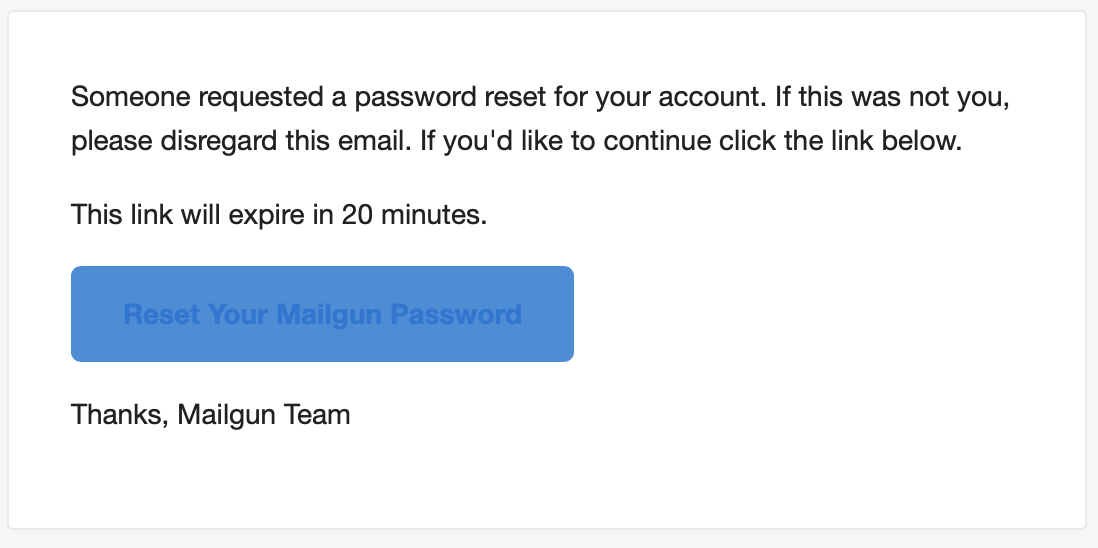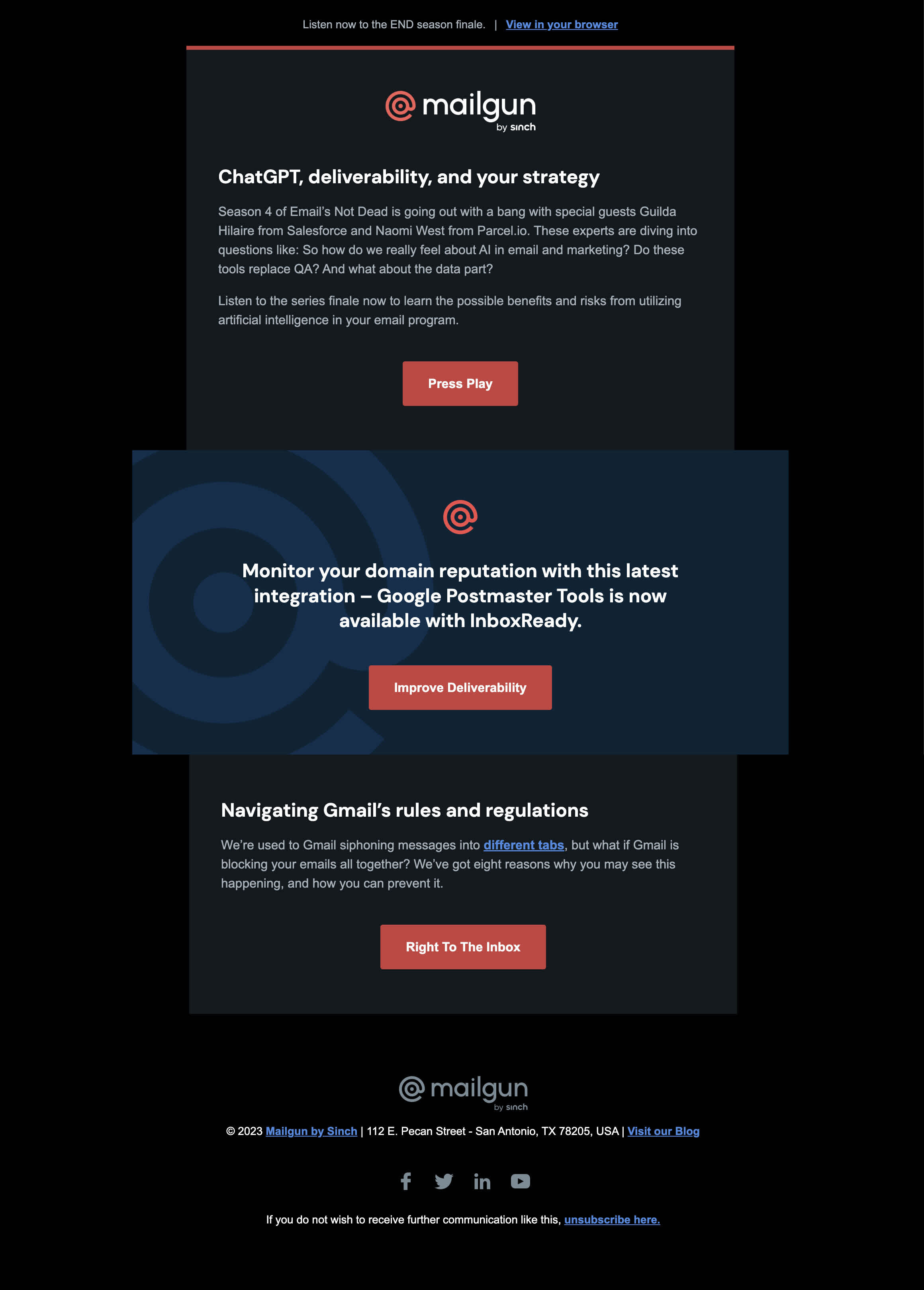Home
Mailgun Blog
Deliverability category
Transactional Emails Versus Marketing Emails – Epic Rep Battle
Deliverability
Transactional email vs. Marketing email: Everything you need to know
When you have marketing and transactional emails that have conflicting reputations – things can get messy with your domain reputation and ISPs. The answer is to keep these reputations separate. Learn how in this post.
PUBLISHED ON
Imagine this scenario — you’re a sender that is sending massive amounts of email left and right from the same domain without a care in the world about your reputation. Maybe sender reputation is a new concept, maybe you just don’t know where to start. If this is you, you may feel like sending all that email will help build reputation and warm your IP, right? Get yourself a good reputation with ISPs?
No. Stop that.
Now we understand that a lot of times, senders might not know that sending a high volume of email can cause problems for their reputation and email sending as a whole. This is one of those things that a lot of senders learn with time – and sometimes with trial and error. We’re here to help you avoid the error part.
What defines your domain reputation?
Your domain reputation is based on a variety of factors, but the emails you’re sending are a big determining factor. Not all emails serve the same purpose, and that means that they affect your reputation in different ways. Before we get into that, let’s define the emails that affect your reputation the most — transactional emails and marketing emails.
What is a transactional email?
Everybody knows transactional email in some way, shape, or form. Transactional emails are your service helpers, those triggered or automated notifications that play a major role in customer experience. Messages like one-to-one transactional messages sent to users after they interact with a company, website, integration, or application in some way. They often contain information that the user requested and would want on file, so it’s best to have those emails automated.
Some examples of transactional emails would be password reset emails, purchase receipts, welcome emails, order confirmation emails, shipping confirmations and order updates, feedback surveys, ToS updates, and a variety of other notifications for things like account creation.

A lot of people expect to get these emails types of transactional, and they often want them right after the event is triggered. You don’t want your transactional email running into slow send times or a total lack of notifications at all. Like marketing emails, a lot of transactional emails succeed when best practices are followed.
Learn more: Since transactional emails are triggered by user actions, it’s helpful to manage and automate your transactional sending with an API.
What is a marketing email?
Marketing emails are commercial messages and are one of the best ways to get news about your product and services to new or loyal subscribers. The cut and dry definition: marketing emails are solicitations sent to email addresses that have opted-in to receive them.
Learn more: Ensuring your user’s want to receive your messages is key for reputation. You can make that happen for your email program with double opt-in. You’ll also want to include a single-click unsubscribe link as part of planned changes coming from Gmail and Yahoo.
Some examples of marketing emails are anything like newsletters, promotional emails, blog updates, third-party offers, promotional invitations — anything that might land in the Promotions tab of your Gmail inbox if you have those tabs enabled.

When done right, marketing emails are one of the best ways to retain customers and bring a great ROI for your business. It’s an invaluable part of any marketing strategy, so making sure you’re up to best practices is imperative. Not following best practice can lead to problems with your users, your email service provider (ESP), and ISPs, but which one matters more?
Epic reputation battle: Marketing vs transactional emails
Marketing and transactional emails are all just emails that you’re probably already sending between your marketing campaigns and customer notification emails, but how people perceive them is very different. Some users might not be the biggest fans of marketing emails so sentiment can be shaky from time to time. When marketing emails are performing well, your sending reputation is too. However, if your marketing emails are getting low engagements, your reputation can take a hit.
Transaction-based emails, on the other hand, tend to have very high engagement rates. Why? Transactional emails have information that many users need, so they tend to have higher open rates compared to marketing emails. Like we said earlier, transactional emails are sent when a user makes a request and are a bit more technical, so the nature of the email lends itself to higher engagements.
Transactional emails tend to bring you a higher reputation than marketing emails but both can help builk brand awareness and trust. Users are expecting these messages, and they often contain useful information like tracking numbers and confirmations. Sounds like high open rates and click rates to us. Don’t mess this opportunity up, get our best practices here.
When you have emails that might have a lower reputation paired with emails that lend themselves to higher reputation, things can get messy. If your reputation is taking a particularly bad hit, things like password resets and receipts can end up in the spam folder. Transactional emails in spam lead to unhappy customers.
The solution to a strong domain reputation: Subdomains
If you find yourself sitting here going, “Oh crap, this is happening to me!” Don’t freak out too much. This problem can be fixed with subdomains. A subdomain is just an extension of your main domain name, and they really come in handy for this type of organization. Using subdomains for your marketing and transactional emails allows you to separate those domain reputations.
Separation ensures that your transactional program and marketing campagins don’t cause problems for one another should something go haywire with either. Great examples of this would be subdomains like marketing.domain.com or promotions.domain.com for marketing emails and receipts.domain.com or transactions.domain.com for transactional emails.
Now, there are some finer details to subdomains you should know before separating your marketing and your transactional emails. For one, subdomains are best suited to high volume sending. If you aren’t sending tons of email, it’s best to have just one domain to start with to help start a reputation for your brand.
The same can be said for IPs; if you have massive amounts of emails to send, think about separating your IPs to help control your IP reputation and improve your email deliverability.
Second: don’t use something like (code text: donotreply.domain.com)! We see this a lot with senders, and it breaks our hearts because you’re taking out the best engagement – replies! If you have a “do not reply” subdomain setup, create a new one that doesn’t deter customer interaction. If you’re worried about figuring out what to do with all the inbound messages you’ll get, we can help with that.
Learn more: If you’re separating your marketing and transactional email domains, you’ll also want to segment your email list to optimize your sending.
Wrapping up
In an ideal world, all of your emails would have high open and engagement rates across the board. Unfortunately, that is not likely to be the case. By no means should you get rid of either type of email altogether or toss your latest email campaign… you’d be throwing away some of the best customer satisfaction and service tools out there.
However, keeping your marketing and transactional emails separated will help you avoid getting a super sassy complaint on social media about how an email receipt ended up in spam, and your customer relationships and email service provider will thank you.
Managing your sending with subdomains is just one of the email best practices that will ensure your overall deliverability and sender reputation. We’re great sounding boards and strategists for tricky deliverability solutions like this.






